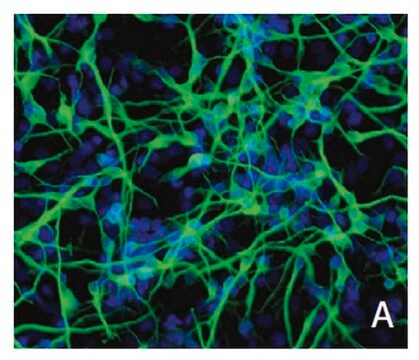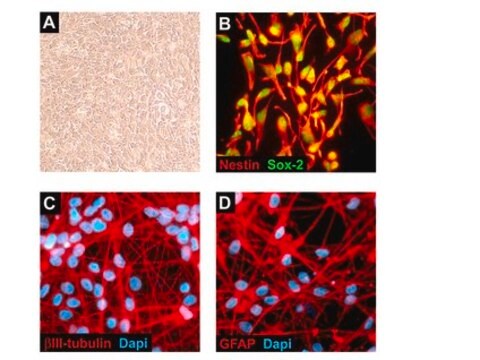SCR047
Pancreatic Cell DTZ Detection Assay
The Pancreatic Cell DTZ Detection Assay provides researcher a simple & quick method to identify insulin-producing beta cells from a mixed cell culture preparation or from pancreatic tissues.
Iniciar sesiónpara Ver la Fijación de precios por contrato y de la organización
About This Item
UNSPSC Code:
12352207
eCl@ss:
32161000
NACRES:
NA.84
Productos recomendados
Quality Level
species reactivity (predicted by homology)
mammals
manufacturer/tradename
Chemicon®
Millipore
technique(s)
cell culture | stem cell: suitable
input
sample type pancreatic stem cell(s)
detection method
colorimetric
shipped in
dry ice
General description
The Pancreatic Cell DTZ Detection Assay provides researcher a simple and quick method to identify insulin-producing beta cells from a mixed cell culture preparation or from pancreatic tissues The kit contains pre-mixed Dithizone Stain, Rinsing Solution and filters for fast preparation and optimized results. Millipore′s Pancreatic Cell DTZ Detection Asssay (SCR047) takes advantage of the high zinc content of pancreatic beta cells and the known action of dithizone, a zinc-chelating agent, to provide a quick and simple enzymatic reaction that allows researcher to reliably identify insulin-producing beta cells from a mixed cell culture preparation or from pancreatic tissues. Along with selectively staining live pancreatic beta-islet cells crimson red, the enzymatic reaction has the advantage of being completely reversible. Kit components include staining and rinse solutions along with filters required for the live staining reactions. Sufficient reagents are supplied to provide for 10 enzymatic reactions at 10 mL volume.
The islets of Langerhans are groups of specialized cells that are dispersed throughout the pancreas. They produce a number of hormones including glucagon, insulin, Pancreatic polypeptide and somatostatin. Insulin is the most critical of these, as it helps regulate glucose metabolism. Insulin is synthesized from a precursor molecule, proinsulin, in the beta cells of the islets of Langerhans. The conversion of proinsulin into the active hormone, insulin, is accomplished by proteolytic enzymes known as prohormone convertases (PC1 and PC2) as well as the exoprotease carboxypeptidase E. These proteolytic enzymes remove the center portion of the molecule, or C-peptide, and the remaining peptide chains (A and B) are cross-linked by disulfide bonds. The crosslinked peptides are the insulin monomer. As the concentration of the protein increases, the monomers assemble into dimers and in the presence of zinc, into hexameric crystals characterized by two Zn2+ atoms per hexameric unit. It is this 2-Zn insulin hexamer that represents the active conformation of the secreted hormone. Given its prominent role in the synthesis, storage and secretion of insulin, it is not surprising that zinc is highly expressed in pancreatic beta cells.
Application
Research Category
Stem Cell Research
Stem Cell Research
The Pancreatic Cell DTZ Detection Assay provides researcher a simple & quick method to identify insulin-producing beta cells from a mixed cell culture preparation or from pancreatic tissues.
Components
1 mL of 100X DTZ Stain Solution (Part No: 2006182)
2 - 150 mL of 1X DTZ Rinse Solution (Part No: 2006183)
10 Millex GP 0.22 uM filters (Part No: SLGPR33RB)
12 Plastic Syringes, 20 mL w/ Luer slip (Part No: XX1102012)
2 - 150 mL of 1X DTZ Rinse Solution (Part No: 2006183)
10 Millex GP 0.22 uM filters (Part No: SLGPR33RB)
12 Plastic Syringes, 20 mL w/ Luer slip (Part No: XX1102012)
Storage and Stability
Store DTZ Stain at -20C. Store all other reagents at room temperature.
Legal Information
CHEMICON is a registered trademark of Merck KGaA, Darmstadt, Germany
Disclaimer
Unless otherwise stated in our catalog or other company documentation accompanying the product(s), our products are intended for research use only and are not to be used for any other purpose, which includes but is not limited to, unauthorized commercial uses, in vitro diagnostic uses, ex vivo or in vivo therapeutic uses or any type of consumption or application to humans or animals.
Storage Class
10 - Combustible liquids
Certificados de análisis (COA)
Busque Certificados de análisis (COA) introduciendo el número de lote del producto. Los números de lote se encuentran en la etiqueta del producto después de las palabras «Lot» o «Batch»
¿Ya tiene este producto?
Encuentre la documentación para los productos que ha comprado recientemente en la Biblioteca de documentos.
Nuestro equipo de científicos tiene experiencia en todas las áreas de investigación: Ciencias de la vida, Ciencia de los materiales, Síntesis química, Cromatografía, Analítica y muchas otras.
Póngase en contacto con el Servicio técnico





